Planning for Urban Sustainability through Residents’ Wellbeing: The Effects of Nature Interactions, Social Capital, and Socio-Demographic Factors
Abstract
1. Introduction
1.1. Human Wellbeing
1.2. Nature Interactions
1.3. Neighborhood Dynamics
1.4. Socio-Demographic Factors
2. Materials and Methods
2.1. Study Area
2.2. Survey Methods
2.3. Dependent Variables
2.4. Explanatory Variables
2.4.1. Nature Activities
2.4.2. Neighborhood Factors
2.4.3. Socio-Demographic Variables
2.5. Analyses
3. Results
3.1. Subjective Wellbeing
3.2. Physical Health
3.3. Mental Health
3.4. Comparing Models
4. Discussion
4.1. Local Nature Interactions and Satisfaction during the COVID Pandemic
4.2. Neighborhood Design for Social Engagement and Justice
4.3. Interventions Centered on Perceptions and Diverse Voices
4.4. Nature Interactions and Mental Health
4.5. Limitations and Future Research
5. Conclusions
Supplementary Materials
Author Contributions
Funding
Institutional Review Board Statement
Informed Consent Statement
Data Availability Statement
Acknowledgments
Conflicts of Interest
References
- The World Bank Urban Population (% of Total Population). Available online: https://data.worldbank.org/indicator/SP.URB.TOTL.IN.ZS?locations=US (accessed on 1 April 2023).
- Lederbogen, F.; Kirsch, P.; Haddad, L.; Streit, F.; Tost, H.; Schuch, P.; Wüst, S.; Pruessner, J.C.; Rietschel, M.; Deuschle, M.; et al. City Living and Urban Upbringing Affect Neural Social Stress Processing in Humans. Nature 2011, 474, 498–501. [Google Scholar] [CrossRef] [PubMed]
- Soga, M.; Gaston, K.J. Extinction of Experience: The Loss of Human–Nature Interactions. Front. Ecol. Environ. 2016, 14, 94–101. [Google Scholar] [CrossRef]
- Carrus, G.; Scopelliti, M.; Lafortezza, R.; Colangelo, G.; Ferrini, F.; Salbitano, F.; Agrimi, M.; Portoghesi, L.; Semenzato, P.; Sanesi, G. Go Greener, Feel Better? The Positive Effects of Biodiversity on the Well-Being of Individuals Visiting Urban and Peri-Urban Green Areas. Landsc. Urban Plan. 2015, 134, 221–228. [Google Scholar] [CrossRef]
- Nisbet, E.K.; Zelenski, J.M. Underestimating Nearby Nature: Affective Forecasting Errors Obscure the Happy Path to Sustainability. Psychol. Sci. 2011, 22, 1101–1106. [Google Scholar] [CrossRef]
- Theodorou, A.; Panno, A.; Carrus, G.; Carbone, G.A.; Massullo, C.; Imperatori, C. Stay Home, Stay Safe, Stay Green: The Role of Gardening Activities on Mental Health during the COVID-19 Home Confinement. Urban For. Urban Green. 2021, 61, 127091. [Google Scholar] [CrossRef] [PubMed]
- Kaczynski, A.T.; Henderson, K.A. Environmental Correlates of Physical Activity: A Review of Evidence about Parks and Recreation. Leis. Sci. 2007, 29, 315–354. [Google Scholar] [CrossRef]
- Dodge, R.; Daly, A.P.; Huyton, J.; Sanders, L.D. The Challenge of Defining Wellbeing. Int. J. Wellbeing 2012, 2, 222–235. [Google Scholar] [CrossRef]
- Placa, V.L.; McNaught, A.; Knight, A. Discourse on Wellbeing in Research and Practice. Int. J. Wellbeing 2013, 3, 116–125. [Google Scholar] [CrossRef]
- Adler, A.; Seligman, M.E.P. Using Wellbeing for Public Policy: Theory, Measurement, and Recommendations. Int. J. Wellbeing 2016, 6, 1–35. [Google Scholar] [CrossRef]
- Dobewall, H.; Tark, R.; Aavik, T. Health as a Value and Its Association with Health-Related Quality of Life, Mental Health, Physical Health, and Subjective Well-Being. Appl. Res. Qual. Life 2018, 13, 859–872. [Google Scholar] [CrossRef]
- Lehberger, M.; Kleih, A.-K.; Sparke, K. Self-Reported Well-Being and the Importance of Green Spaces—A Comparison of Garden Owners and Non-Garden Owners in Times of COVID-19. Landsc. Urban Plan. 2021, 212, 104108. [Google Scholar] [CrossRef]
- Diener, E.; Emmons, R.A.; Larsen, R.J.; Griffin, S. The Satisfaction With Life Scale. J. Pers. Assess. 1985, 49, 71–75. [Google Scholar] [CrossRef]
- Angner, E. Subjective Well-Being. J. Socio-Econ. 2010, 39, 361–368. [Google Scholar] [CrossRef]
- Diener, E.; Oishi, S.; Tay, L. Advances in Subjective Well-Being Research. Nat. Hum. Behav. 2018, 2, 253–260. [Google Scholar] [CrossRef]
- Huber, M.; Knottnerus, J.A.; Green, L.; Horst, H.v.d.; Jadad, A.R.; Kromhout, D.; Leonard, B.; Lorig, K.; Loureiro, M.I.; Meer, J.W.M.v.d.; et al. How Should We Define Health? BMJ 2011, 343, d4163. [Google Scholar] [CrossRef] [PubMed]
- Xu, J.; Murphy, S.L.; Kochanek, K.D.; Arias, E. Mortality in the United States, 2021; National Center for Health Statistics: Hyattsville, MD, USA, 2022. [Google Scholar]
- CDC Obesity Data and Statistics. Available online: https://www.cdc.gov/obesity/data/index.html (accessed on 17 March 2023).
- Centers for Disease Control and Prevention. Available online: https://www.cdc.gov/nchs/fastats/mental-health.htm (accessed on 17 April 2024).
- Shanahan, D.F.; Bush, R.; Gaston, K.J.; Lin, B.B.; Dean, J.; Barber, E.; Fuller, R.A. Health Benefits from Nature Experiences Depend on Dose. Sci. Rep. 2016, 6, 28551. [Google Scholar] [CrossRef]
- Stock, S.; Bu, F.; Fancourt, D.; Mak, H.W. Going Outdoors, Neighbourhood Satisfaction and Mental Health and Wellbeing during a COVID-19 Lockdown: A Fixed-Effects Analysis. PsyArXiv Preprints 2021. [Google Scholar] [CrossRef]
- Hartig, T.; Mitchell, R.; de Vries, S.; Frumkin, H. Nature and Health. Annu. Rev. Public Health 2014, 35, 207–228. [Google Scholar] [CrossRef]
- Hughey, S.M.; Wende, M.E.; Stowe, E.W.; Kaczynski, A.T.; Schipperijn, J.; Hipp, J.A. Frequency of Neighborhood Park Use Is Associated With Physical Activity Among Adults in Four US Cities. J. Phys. Act. Health 2021, 18, 603–609. [Google Scholar] [CrossRef]
- Kaczynski, A.T.; Potwarka, L.R.; Saelens, B.E. Association of Park Size, Distance, and Features With Physical Activity in Neighborhood Parks. Am. J. Public Health 2008, 98, 1451–1456. [Google Scholar] [CrossRef]
- Larson, K.L.; Nelson, K.C.; Samples, S.R.; Hall, S.J.; Bettez, N.; Cavender-Bares, J.; Groffman, P.M.; Grove, M.; Heffernan, J.B.; Hobbie, S.E.; et al. Ecosystem Services in Managing Residential Landscapes: Priorities, Value Dimensions, and Cross-Regional Patterns. Urban Ecosyst. 2016, 19, 95–113. [Google Scholar] [CrossRef]
- Pfeiffer, D.; Cloutier, S. Planning for Happy Neighborhoods. J. Am. Plann. Assoc. 2016, 82, 267–279. [Google Scholar] [CrossRef]
- Cohen, D.A.; McKenzie, T.L.; Sehgal, A.; Williamson, S.; Golinelli, D.; Lurie, N. Contribution of Public Parks to Physical Activity. Am. J. Public Health 2007, 97, 509–514. [Google Scholar] [CrossRef]
- Turrell, G.; Nathan, A.; Burton, N.W.; Brown, W.J.; McElwee, P.; Barnett, A.G.; Pachana, N.A.; Oldenburg, B.; Rachele, J.N.; Giskes, K.; et al. Cohort Profile: HABITAT—A Longitudinal Multilevel Study of Physical Activity, Sedentary Behaviour and Health and Functioning in Mid-to-Late Adulthood. Int. J. Epidemiol. 2021, 50, 730–731h. [Google Scholar] [CrossRef]
- Wu, W.; Dong, G.; Sun, Y.; Yun, Y. Contextualized Effects of Park Access and Usage on Residential Satisfaction: A Spatial Approach. Land Use Policy 2020, 94, 104532. [Google Scholar] [CrossRef]
- Mouratidis, K. Neighborhood Characteristics, Neighborhood Satisfaction, and Well-Being: The Links with Neighborhood Deprivation. Land Use Policy 2020, 99, 104886. [Google Scholar] [CrossRef]
- Wilson, D.K.; Kirtland, K.A.; Ainsworth, B.E.; Addy, C.L. Socioeconomic Status and Perceptions of Access and Safety for Physical Activity. Ann. Behav. Med. 2004, 28, 20–28. [Google Scholar] [CrossRef]
- Coventry, P.A.; Brown, J.V.E.; Pervin, J.; Brabyn, S.; Pateman, R.; Breedvelt, J.; Gilbody, S.; Stancliffe, R.; McEachan, R.; White, P. Nature-Based Outdoor Activities for Mental and Physical Health: Systematic Review and Meta-Analysis. SSM—Popul. Health 2021, 16, 100934. [Google Scholar] [CrossRef]
- Egerer, M.; Lin, B.; Kingsley, J.; Marsh, P.; Diekmann, L.; Ossola, A. Gardening Can Relieve Human Stress and Boost Nature Connection during the COVID-19 Pandemic. Urban For. Urban Green. 2022, 68, 127483. [Google Scholar] [CrossRef]
- Shen, X.; MacDonald, M.; Logan, S.W.; Parkinson, C.; Gorrell, L.; Hatfield, B.E. Leisure Engagement during COVID-19 and Its Association with Mental Health and Wellbeing in U.S. Adults. Int. J. Environ. Res. Public Health 2022, 19, 1081. [Google Scholar] [CrossRef]
- Marques, P.; Silva, A.S.; Quaresma, Y.; Manna, L.R.; de Magalhães Neto, N.; Mazzoni, R. Home Gardens Can Be More Important than Other Urban Green Infrastructure for Mental Well-Being during COVID-19 Pandemics. Urban For. Urban Green. 2021, 64, 127268. [Google Scholar] [CrossRef] [PubMed]
- Marsh, P.; Diekmann, L.O.; Egerer, M.; Lin, B.; Ossola, A.; Kingsley, J. Where Birds Felt Louder: The Garden as a Refuge during COVID-19. Wellbeing Space Soc. 2021, 2, 100055. [Google Scholar] [CrossRef] [PubMed]
- Morse, K.F.; Fine, P.A.; Friedlander, K.J. Creativity and Leisure During COVID-19: Examining the Relationship Between Leisure Activities, Motivations, and Psychological Well-Being. Front. Psychol. 2021, 12, 609967. [Google Scholar] [CrossRef] [PubMed]
- Vogel, E.A.; Zhang, J.S.; Peng, K.; Heaney, C.A.; Lu, Y.; Lounsbury, D.; Hsing, A.W.; Prochaska, J.J. Physical Activity and Stress Management during COVID-19: A Longitudinal Survey Study. Psychol. Health 2022, 37, 51–61. [Google Scholar] [CrossRef] [PubMed]
- Morse, J.W.; Gladkikh, T.M.; Hackenburg, D.M.; Gould, R.K. COVID-19 and Human-Nature Relationships: Vermonters’ Activities in Nature and Associated Nonmaterial Values during the Pandemic. PLoS ONE 2020, 15, e0243697. [Google Scholar] [CrossRef] [PubMed]
- Talen, E. Neighborhood; Oxford University Press: Oxford, UK, 2018; ISBN 978-0-19-090751-8. [Google Scholar]
- Weiss, L.; Ompad, D.; Galea, S.; Vlahov, D. Defining Neighborhood Boundaries for Urban Health Research. Am. J. Prev. Med. 2007, 32, S154–S159. [Google Scholar] [CrossRef] [PubMed]
- Kingsley, J.; Egerer, M.; Nuttman, S.; Keniger, L.; Pettitt, P.; Frantzeskaki, N.; Gray, T.; Ossola, A.; Lin, B.; Bailey, A.; et al. Urban Agriculture as a Nature-Based Solution to Address Socio-Ecological Challenges in Australian Cities. Urban For. Urban Green. 2021, 60, 127059. [Google Scholar] [CrossRef]
- Larson, K.L.; Andrade, R.; Nelson, K.C.; Wheeler, M.M.; Engebreston, J.M.; Hall, S.J.; Avolio, M.L.; Groffman, P.M.; Grove, M.; Heffernan, J.B.; et al. Municipal Regulation of Residential Landscapes across US Cities: Patterns and Implications for Landscape Sustainability. J. Environ. Manag. 2020, 275, 111132. [Google Scholar] [CrossRef] [PubMed]
- Wu, J. Landscape Sustainability Science: Ecosystem Services and Human Well-Being in Changing Landscapes. Landsc. Ecol. 2013, 28, 999–1023. [Google Scholar] [CrossRef]
- Grineski, S.; Bolin, B.; Boone, C. Criteria Air Pollution and Marginalized Populations: Environmental Inequity in Metropolitan Phoenix, Arizona. Soc. Sci. Q. 2007, 88, 535–554. [Google Scholar] [CrossRef]
- Harlan, S.L.; Brazel, A.J.; Prashad, L.; Stefanov, W.L.; Larsen, L. Neighborhood Microclimates and Vulnerability to Heat Stress. Soc. Sci. Med. 2006, 63, 2847–2863. [Google Scholar] [CrossRef] [PubMed]
- de Vries, S.; van Dillen, S.M.E.; Groenewegen, P.P.; Spreeuwenberg, P. Streetscape Greenery and Health: Stress, Social Cohesion and Physical Activity as Mediators. Soc. Sci. Med. 2013, 94, 26–33. [Google Scholar] [CrossRef] [PubMed]
- Pereira, G.; Foster, S.; Martin, K.; Christian, H.; Boruff, B.J.; Knuiman, M.; Giles-Corti, B. The Association between Neighborhood Greenness and Cardiovascular Disease: An Observational Study. BMC Public Health 2012, 12, 466. [Google Scholar] [CrossRef] [PubMed]
- Larsen, L.; Harlan, S.L.; Bolin, B.; Hackett, E.J.; Hope, D.; Kirby, A.; Nelson, A.; Rex, T.R.; Wolf, S. Bonding and Bridging: Understanding the Relationship between Social Capital and Civic Action. J. Plan. Educ. Res. 2004, 24, 64–77. [Google Scholar] [CrossRef]
- Duh-Leong, C.; Dreyer, B.P.; Huang, T.T.-K.; Katzow, M.; Gross, R.S.; Fierman, A.H.; Tomopoulos, S.; Di Caprio, C.; Yin, H.S. Social Capital as a Positive Social Determinant of Health: A Narrative Review. Acad. Pediatr. 2021, 21, 594–599. [Google Scholar] [CrossRef] [PubMed]
- Maas, J.; van Dillen, S.M.E.; Verheij, R.A.; Groenewegen, P.P. Social Contacts as a Possible Mechanism behind the Relation between Green Space and Health. Health Place 2009, 15, 586–595. [Google Scholar] [CrossRef]
- Pfeiffer, D.; Ehlenz, M.M.; Andrade, R.; Cloutier, S.; Larson, K.L. Do Neighborhood Walkability, Transit, and Parks Relate to Residents’ Life Satisfaction? J. Am. Plann. Assoc. 2020, 86, 171–187. [Google Scholar] [CrossRef]
- Mohnen, S.M.; Groenewegen, P.P.; Völker, B.; Flap, H. Neighborhood Social Capital and Individual Health. Soc. Sci. Med. 2011, 72, 660–667. [Google Scholar] [CrossRef]
- Wadsworth, T.; Pendergast, P. Race, Ethnicity and Subjective Well-Being: Exploring the Disparities in Life Satisfaction Among Whites, Latinx, and Asians. Int. J. Wellbeing 2021, 11, 51–72. [Google Scholar] [CrossRef]
- Mouratidis, K. Commute Satisfaction, Neighborhood Satisfaction, and Housing Satisfaction as Predictors of Subjective Well-Being and Indicators of Urban Livability. Travel Behav. Soc. 2020, 21, 265–278. [Google Scholar] [CrossRef]
- Tan, J.J.X.; Kraus, M.W.; Carpenter, N.C.; Adler, N.E. The Association between Objective and Subjective Socioeconomic Status and Subjective Well-Being: A Meta-Analytic Review. Psychol. Bull. 2020, 146, 970–1020. [Google Scholar] [CrossRef]
- Promoting Health for Older Adults|CDC. Available online: https://www.cdc.gov/chronicdisease/resources/publications/factsheets/promoting-health-for-older-adults.htm (accessed on 31 March 2023).
- González, M.G.; Swanson, D.P.; Lynch, M.; Williams, G.C. Testing Satisfaction of Basic Psychological Needs as a Mediator of the Relationship between Socioeconomic Status and Physical and Mental Health. J. Health Psychol. 2016, 21, 972–982. [Google Scholar] [CrossRef] [PubMed]
- United States Census Bureau. Urban Areas Facts. Available online: https://www.census.gov/programs-surveys/geography/guidance/geo-areas/urban-rural/ua-facts.html (accessed on 1 April 2023).
- US Department of Commerce, National Oceanic and Atmospheric Administration. 2021 Climate Year in Review for Phoenix, Yuma, and El Centro. Available online: https://www.weather.gov/psr/yearinreview2021 (accessed on 23 January 2023).
- Linch, C. Phoenix, Gilbert Restrict Some Activities, but Most Arizona Parks and Trails Remain Open. Cronkite News—Arizona PBS, 30 March 2020. [Google Scholar]
- Larson, K.L.; Brown, J.A.; Andrade, R.; Avilez, D.; Davitt, A.; Siefert, J.; York, A. The Phoenix Area Social Survey V: Analyzing Neighborhood Social-Ecological Dynamics and Change over Time. A Report Published by the Central Arizona–Phoenix Long-Term Ecological Research (CAP LTER) Site. 2021. Available online: https://sustainability-innovation.asu.edu/caplter/research/long-term-monitoring/phoenix-area-social-survey/ (accessed on 1 April 2023).
- Rigolon, A. A Complex Landscape of Inequity in Access to Urban Parks: A Literature Review. Landsc. Urban Plan. 2016, 153, 160–169. [Google Scholar] [CrossRef]
- Rouse, J.W.; Haas, R.H.; Schell, J.A.; Deering, D.W. Monitoring Vegetation Systems in the Great Plains with ERTS; NASA: Washington, DC, USA, 1974. [Google Scholar]
- Larson, K.L.; Brown, J.A.; Lee, K.J.; Pearsall, H. Park Equity: Why Subjective Measures Matter. Urban For. Urban Green. 2022, 76, 127733. [Google Scholar] [CrossRef]
- Talen, E. Large Urban Developments and the Future of Cities: The Case of Neighborhoods. Urban Plan. 2019, 4, 4–5. [Google Scholar] [CrossRef]
- Soga, M.; Evans, M.J.; Cox, D.T.C.; Gaston, K.J. Impacts of the COVID-19 Pandemic on Human–Nature Interactions: Pathways, Evidence and Implications. People Nat. 2021, 3, 518–527. [Google Scholar] [CrossRef] [PubMed]
- Alteri, L.; Parks, L.; Raffini, L.; Vitale, T. COVID-19 and the Structural Crisis of Liberal Democracies. Determinants and Consequences of the Governance of Pandemic. Partecip. E Conflitto 2021, 14, 1–37. [Google Scholar] [CrossRef]
- Ayala-Azcárraga, C.; Diaz, D.; Zambrano, L. Characteristics of Urban Parks and Their Relation to User Well-Being. Landsc. Urban Plan. 2019, 189, 27–35. [Google Scholar] [CrossRef]
- Leyden, K.M. Social Capital and the Built Environment: The Importance of Walkable Neighborhoods. Am. J. Public Health 2003, 93, 1546–1551. [Google Scholar] [CrossRef]
- Oldenburg, R. The Great Good Place: Cafes, Coffee Shops, Bookstores, Bars, Hair Salons, and Other Hangouts at the Heart of a Community; Marlowe: Berkeley, CA, USA, 1999; ISBN 978-1-56924-681-8. [Google Scholar]
- Pfeiffer, D.; Ehlenz, M.; Saadaoui, R. Coping and Connecting through Creativity in the Neighborhood Realm during COVID-19. J. Plan. Educ. Res. 2022, 0739456X221125443. [Google Scholar] [CrossRef]
- Cole, H.V.S.; Garcia Lamarca, M.; Connolly, J.J.T.; Anguelovski, I. Are Green Cities Healthy and Equitable? Unpacking the Relationship between Health, Green Space and Gentrification. J. Epidemiol. Community Health 2017, 71, 1118–1121. [Google Scholar] [CrossRef] [PubMed]
- Jelks, N.O.; Jennings, V.; Rigolon, A. Green Gentrification and Health: A Scoping Review. Int. J. Environ. Res. Public Health 2021, 18, 907. [Google Scholar] [CrossRef] [PubMed]
- Rigolon, A.; Keith, S.J.; Harris, B.; Mullenbach, L.E.; Larson, L.R.; Rushing, J. More than “Just Green Enough”: Helping Park Professionals Achieve Equitable Greening and Limit Environmental Gentrification. J. Park Recreat. Adm. 2020, 38, 402–420. [Google Scholar] [CrossRef]
- Kearney, A.R. Residential Development Patterns and Neighborhood Satisfaction. Environ. Behav. 2006, 38, 112–139. [Google Scholar] [CrossRef]
- Forgione, M. $30.6 Million Tops Prices of New Homes Inside Arizona’s Phoenix Mountains Preserve. Available online: https://www.forbes.com/sites/forbes-global-properties/2023/03/31/306-million-tops-prices-of-new-homes-inside-arizonas-phoenix-mountains-preserve/ (accessed on 21 January 2024).
- Nesbitt, L.; Meitner, M.J.; Girling, C.; Sheppard, S.R.J.; Lu, Y. Who Has Access to Urban Vegetation? A Spatial Analysis of Distributional Green Equity in 10 US Cities. Landsc. Urban Plan. 2019, 181, 51–79. [Google Scholar] [CrossRef]
- Vitale, T. Regulation by Incentives, Regulation of the Incentives in Urban Policies. Transnatl. Corp. Rev. 2010, 2, 35–45. [Google Scholar] [CrossRef]
- Garcia, I.; Garfinkel-Castro, A.; Pfeiffer, D. Planning with Diverse Communities; American Planning Association: Chicago, IL, USA, 2019. [Google Scholar]
- Cuevas, A.G.; Chen, R.; Slopen, N.; Thurber, K.A.; Wilson, N.; Economos, C.; Williams, D.R. Assessing the Role of Health Behaviors, Socioeconomic Status, and Cumulative Stress for Racial/Ethnic Disparities in Obesity. Obesity 2020, 28, 161–170. [Google Scholar] [CrossRef] [PubMed]
- Whittle, H.J.; Palar, K.; Hufstedler, L.L.; Seligman, H.K.; Frongillo, E.A.; Weiser, S.D. Food Insecurity, Chronic Illness, and Gentrification in the San Francisco Bay Area: An Example of Structural Violence in United States Public Policy. Soc. Sci. Med. 2015, 143, 154–161. [Google Scholar] [CrossRef] [PubMed]
- Rigolon, A.; Browning, M.H.E.M.; Lee, K.; Shin, S. Access to Urban Green Space in Cities of the Global South: A Systematic Literature Review. Urban Sci. 2018, 2, 67. [Google Scholar] [CrossRef]
- Mitten, D.; Overholt, J.R.; Haynes, F.I.; D’Amore, C.C.; Ady, J.C. Hiking: A Low-Cost, Accessible Intervention to Promote Health Benefits. Am. J. Lifestyle Med. 2018, 12, 302–310. [Google Scholar] [CrossRef]
- Wolf, I.D.; Wohlfart, T. Walking, Hiking and Running in Parks: A Multidisciplinary Assessment of Health and Well-Being Benefits. Landsc. Urban Plan. 2014, 130, 89–103. [Google Scholar] [CrossRef]
- Jennings, V.; Larson, L.; Yun, J. Advancing Sustainability through Urban Green Space: Cultural Ecosystem Services, Equity, and Social Determinants of Health. Int. J. Environ. Res. Public Health 2016, 13, 196. [Google Scholar] [CrossRef] [PubMed]
- Keniger, L.; Gaston, K.; Irvine, K.; Fuller, R. What Are the Benefits of Interacting with Nature? Int. J. Environ. Res. Public Health 2013, 10, 913–935. [Google Scholar] [CrossRef]
- Moore, T.H.M.; Kesten, J.M.; López-López, J.A.; Ijaz, S.; McAleenan, A.; Richards, A.; Gray, S.; Savović, J.; Audrey, S. The Effects of Changes to the Built Environment on the Mental Health and Well-Being of Adults: Systematic Review. Health Place 2018, 53, 237–257. [Google Scholar] [CrossRef] [PubMed]
- Barger, S.D.; Donoho, C.J.; Wayment, H.A. The Relative Contributions of Race/Ethnicity, Socioeconomic Status, Health, and Social Relationships to Life Satisfaction in the United States. Qual. Life Res. 2009, 18, 179–189. [Google Scholar] [CrossRef]
- Alegria, M.; Canino, G.; Shrout, P.E.; Woo, M.; Duan, N.; Vila, D.; Torres, M.; Chen, C.; Meng, X.-L. Prevalence of Mental Illness in Immigrant and Non-Immigrant U.S. Latino Groups. Am. J. Psychiatry 2008, 165, 359–369. [Google Scholar] [CrossRef]
- Erving, C.L. Physical-Psychiatric Comorbidity: Implications for Health Measurement and the Hispanic Epidemiological Paradox. Soc. Sci. Res. 2017, 64, 197–213. [Google Scholar] [CrossRef]
- Santos-Lozada, A.R. Self-Rated Mental Health and Race/Ethnicity in the United States: Support for the Epidemiological Paradox. PeerJ 2016, 4, e2508. [Google Scholar] [CrossRef]
- Eghaneyan, B.H.; Murphy, E.R. Measuring Mental Illness Stigma among Hispanics: A Systematic Review. Stigma Health 2020, 5, 351–363. [Google Scholar] [CrossRef]
- Ali, A.M.; Alkhamees, A.A.; Hori, H.; Kim, Y.; Kunugi, H. The Depression Anxiety Stress Scale 21: Development and Validation of the Depression Anxiety Stress Scale 8-Item in Psychiatric Patients and the General Public for Easier Mental Health Measurement in a Post COVID-19 World. Int. J. Environ. Res. Public Health 2021, 18, 10142. [Google Scholar] [CrossRef]
- Kocalevent, R.-D.; Hinz, A.; Brähler, E. Standardization of a Screening Instrument (PHQ-15) for Somatization Syndromes in the General Population. BMC Psychiatry 2013, 13, 91. [Google Scholar] [CrossRef] [PubMed]
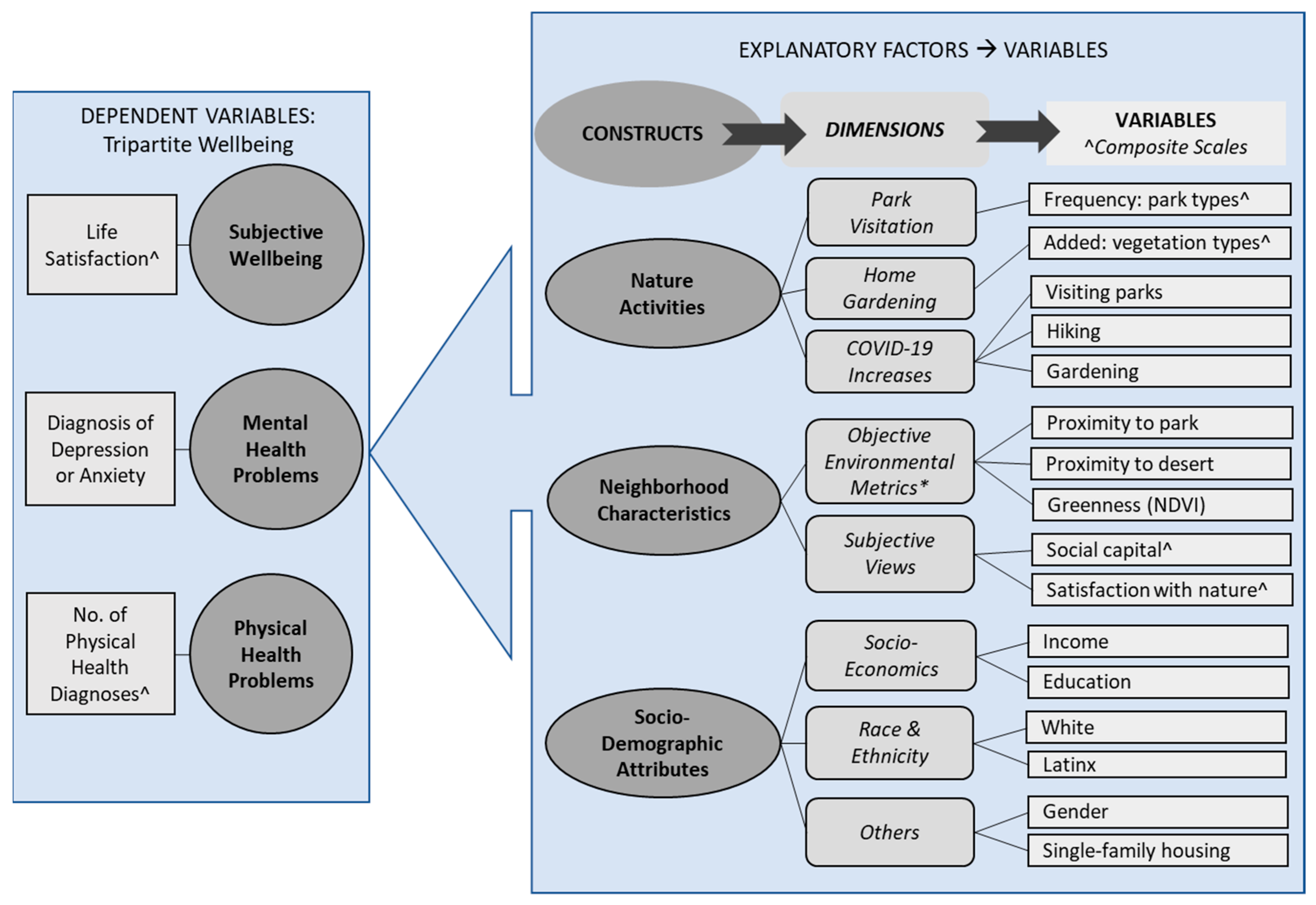
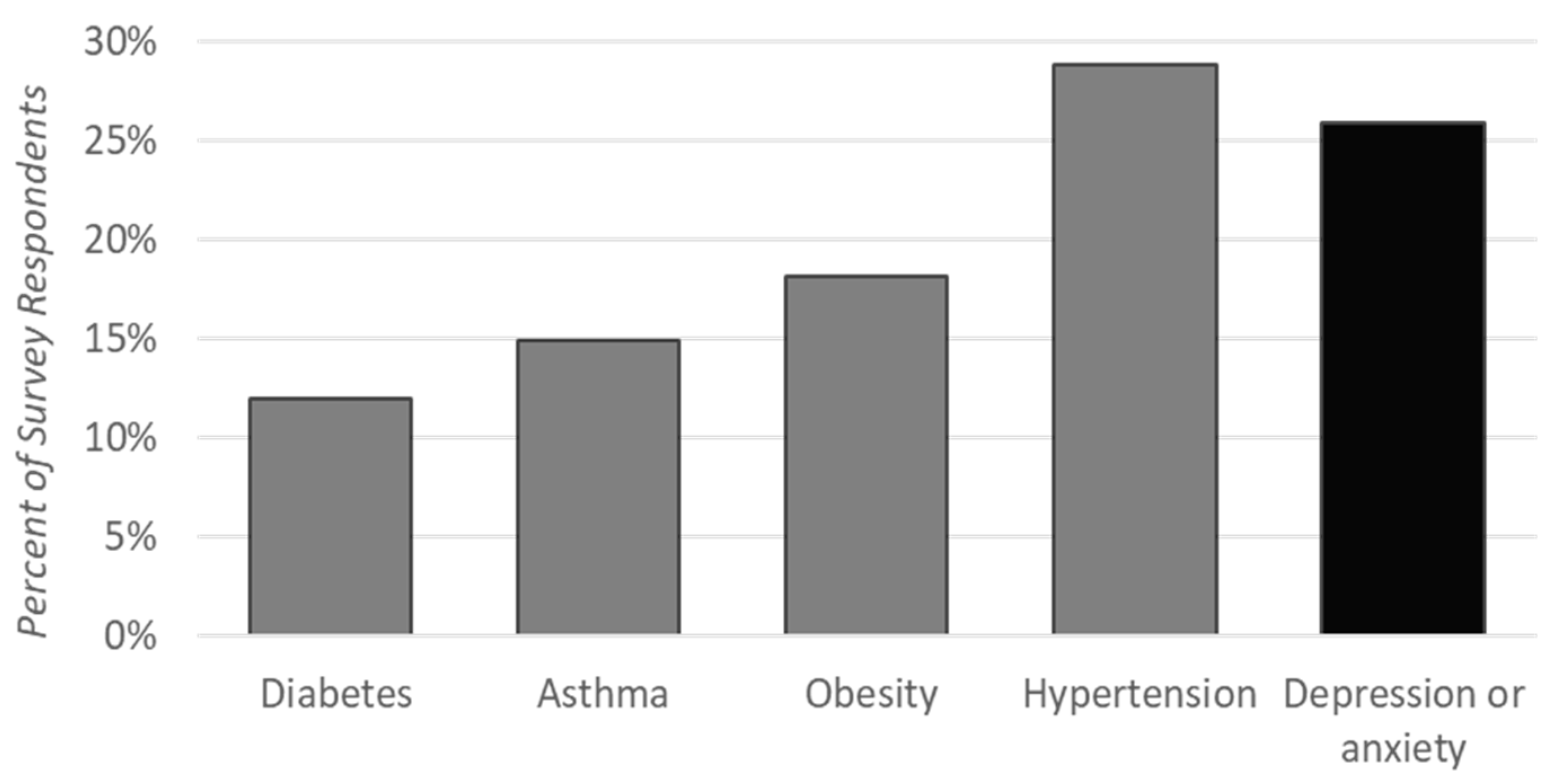
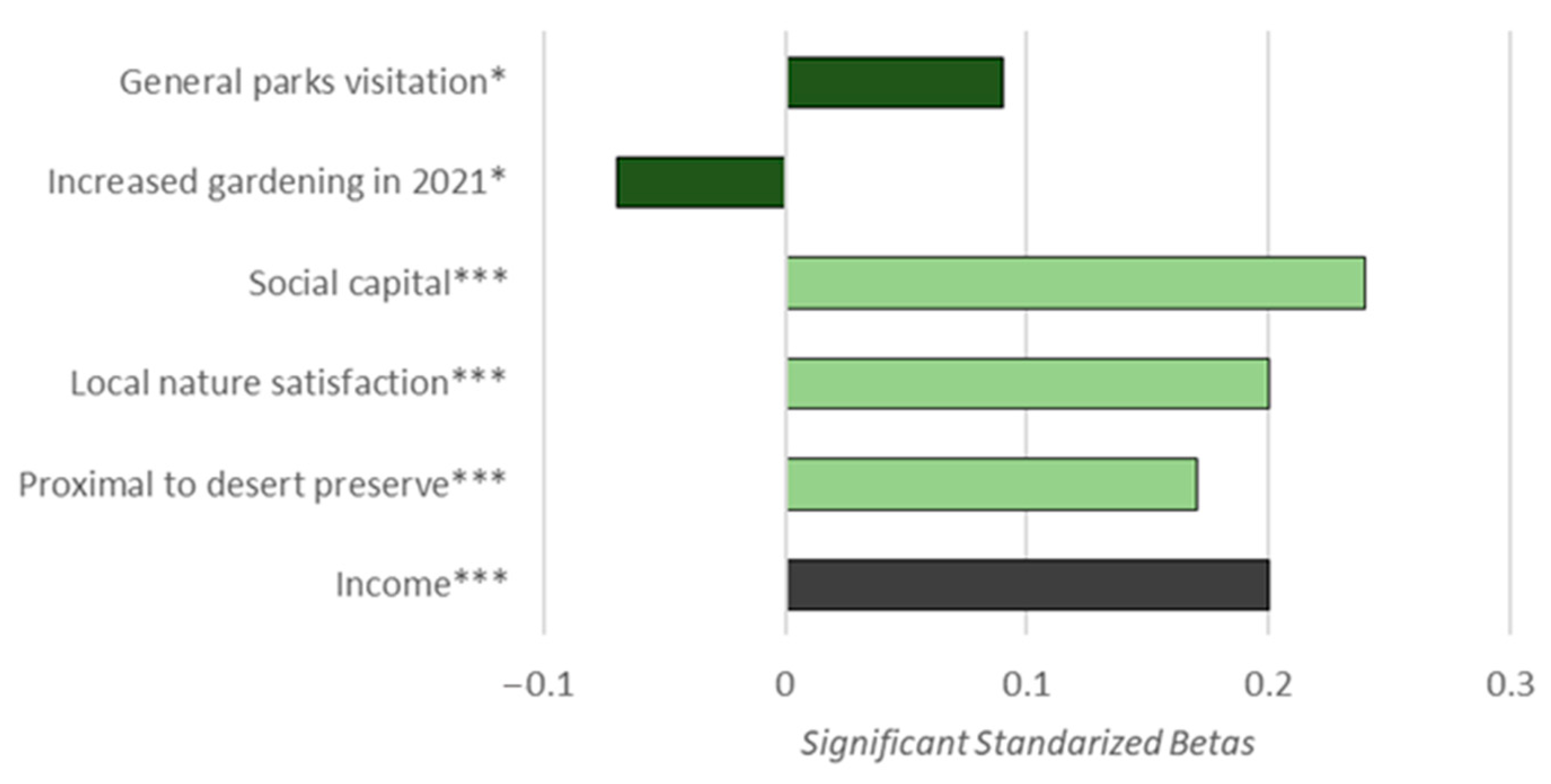
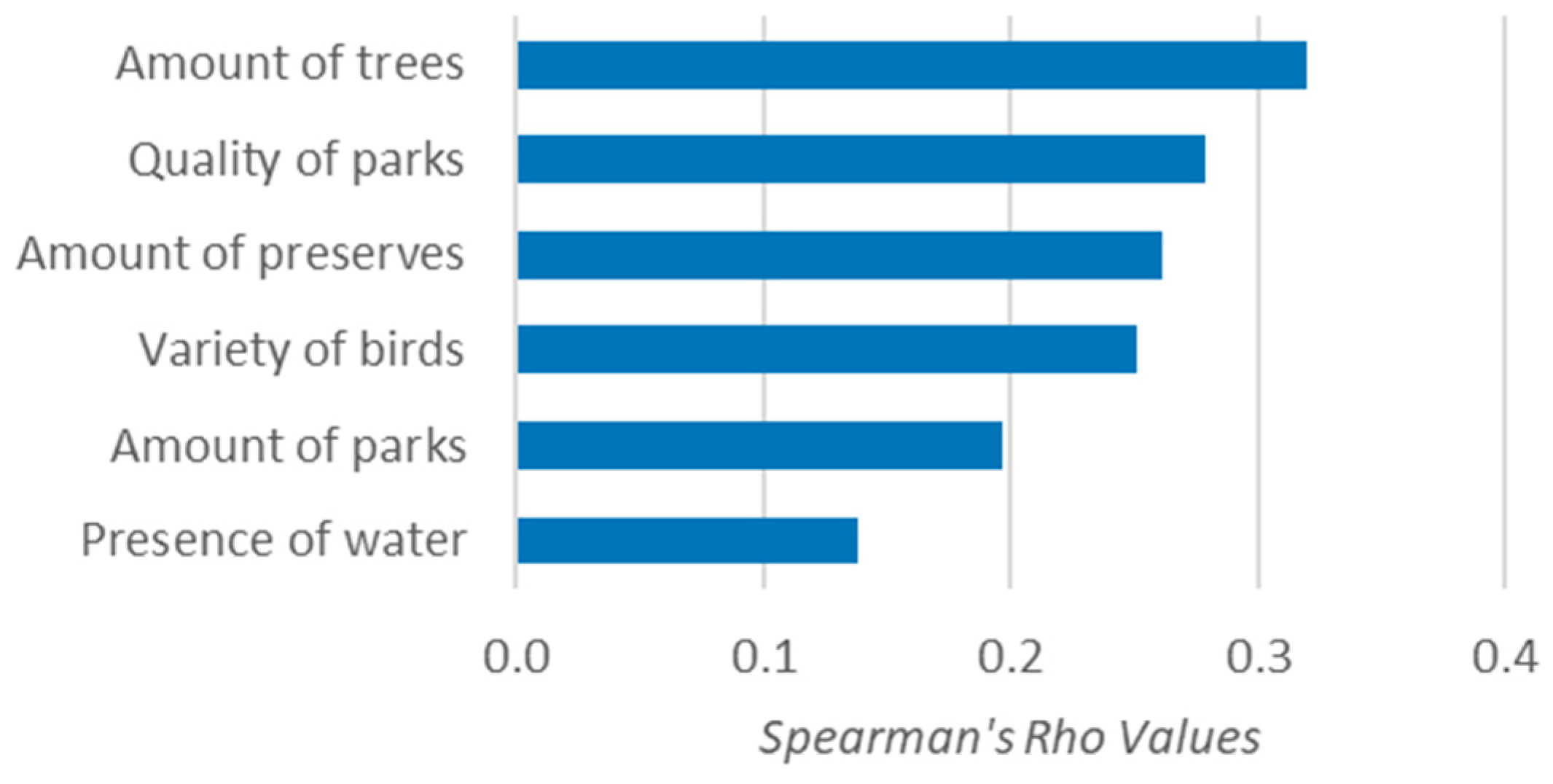
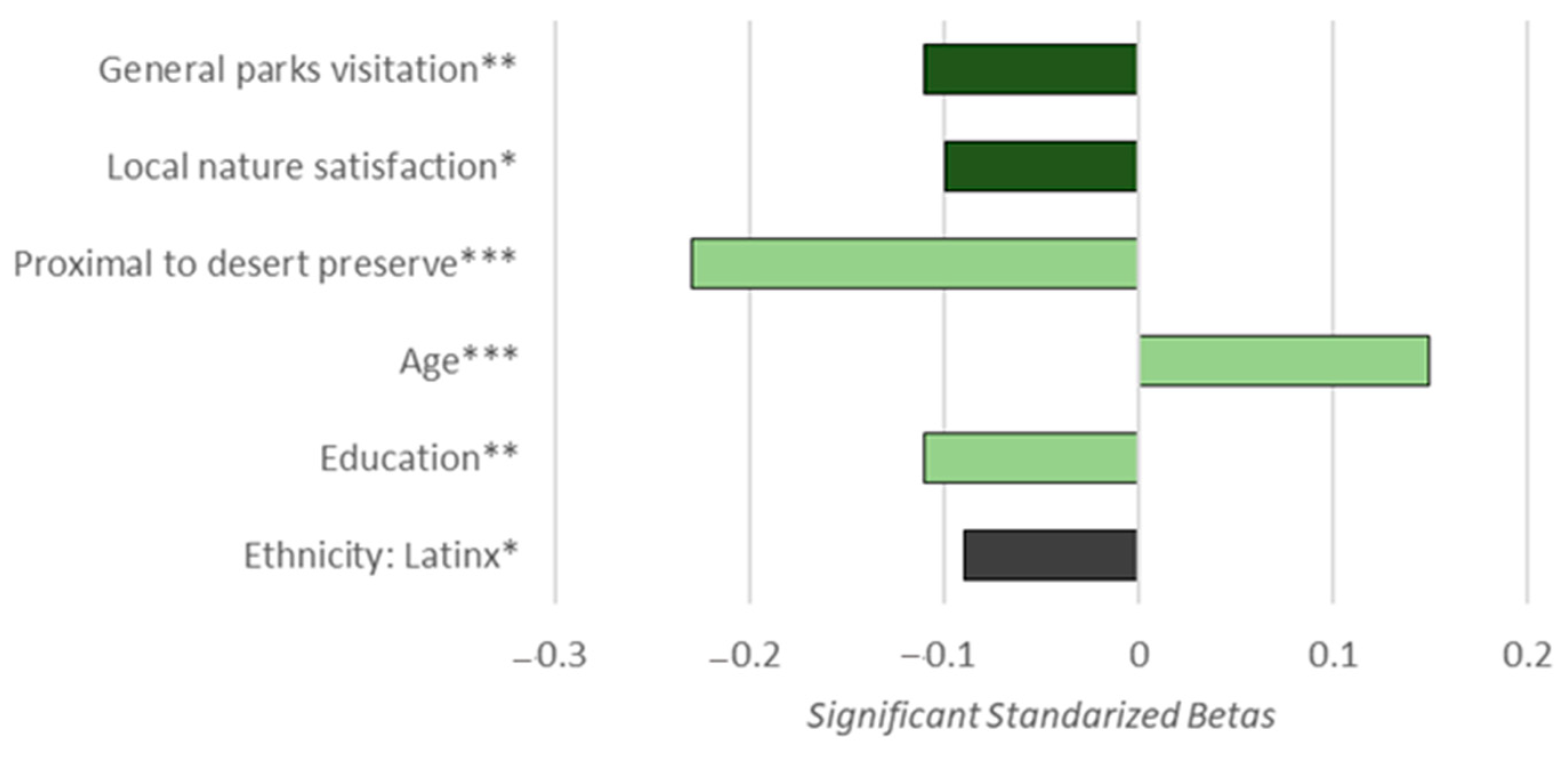
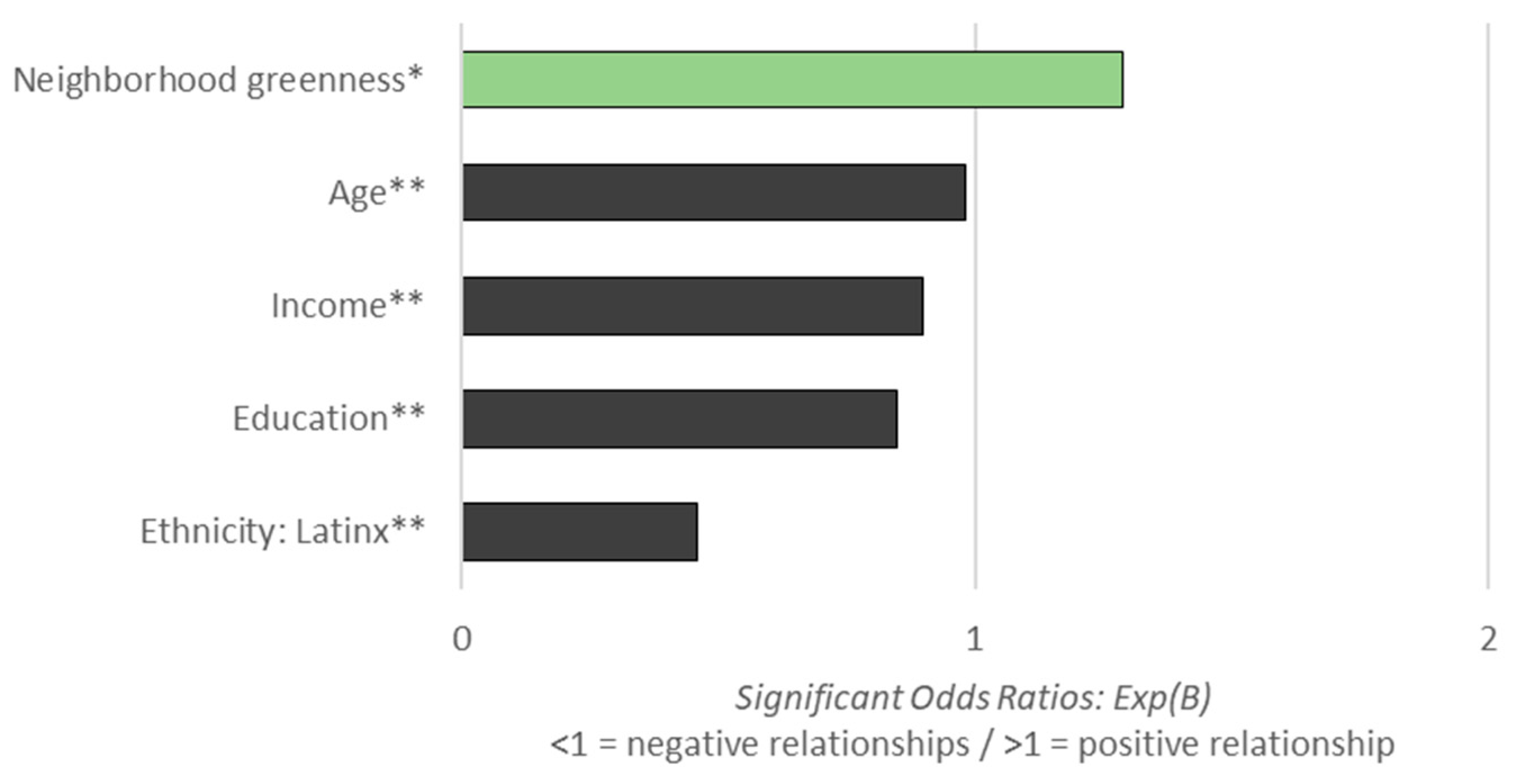
| Explanatory Variables | Subjective Wellbeing | Physical Health Problems | Mental Health Problems |
|---|---|---|---|
| Std B | Std B | Exp(B) † | |
| Nature Activities | |||
| General parks visitation | 0.09 ^ | −0.11 * | |
| Increased gardening in 2021 | −0.07 ^ | ||
| Local Environment | |||
| Social capital | 0.24 ** | ||
| Local nature satisfaction | 0.20 ** | −0.10 ^ | |
| Neighborhood greenness | 1.29 ^ | ||
| Proximal to desert preserve | 0.17 ** | −0.23 ** | |
| Socio-Demographics | |||
| Income | 0.20 ** | 0.90 * | |
| Education | −0.11 * | 0.85 * | |
| Age | 0.15 ** | 0.98 * | |
| Ethnicity: Latinx | −0.09 ^ | 0.46 * | |
| Model Fit | R2 = 0.318 F = 14.28 (p < 0.001) | R2 = 0.092 F = 3.96 (p < 0.001) | Cox and Snell R2 = 0.085 Nagelkerke R2 = 0.122 |
Disclaimer/Publisher’s Note: The statements, opinions and data contained in all publications are solely those of the individual author(s) and contributor(s) and not of MDPI and/or the editor(s). MDPI and/or the editor(s) disclaim responsibility for any injury to people or property resulting from any ideas, methods, instructions or products referred to in the content. |
© 2024 by the authors. Licensee MDPI, Basel, Switzerland. This article is an open access article distributed under the terms and conditions of the Creative Commons Attribution (CC BY) license (https://creativecommons.org/licenses/by/4.0/).
Share and Cite
Mitchell, A.; Larson, K.L.; Pfeiffer, D.; Rosales Chavez, J.-B. Planning for Urban Sustainability through Residents’ Wellbeing: The Effects of Nature Interactions, Social Capital, and Socio-Demographic Factors. Sustainability 2024, 16, 4160. https://doi.org/10.3390/su16104160
Mitchell A, Larson KL, Pfeiffer D, Rosales Chavez J-B. Planning for Urban Sustainability through Residents’ Wellbeing: The Effects of Nature Interactions, Social Capital, and Socio-Demographic Factors. Sustainability. 2024; 16(10):4160. https://doi.org/10.3390/su16104160
Chicago/Turabian StyleMitchell, Abigail, Kelli L. Larson, Deirdre Pfeiffer, and Jose-Benito Rosales Chavez. 2024. "Planning for Urban Sustainability through Residents’ Wellbeing: The Effects of Nature Interactions, Social Capital, and Socio-Demographic Factors" Sustainability 16, no. 10: 4160. https://doi.org/10.3390/su16104160
APA StyleMitchell, A., Larson, K. L., Pfeiffer, D., & Rosales Chavez, J.-B. (2024). Planning for Urban Sustainability through Residents’ Wellbeing: The Effects of Nature Interactions, Social Capital, and Socio-Demographic Factors. Sustainability, 16(10), 4160. https://doi.org/10.3390/su16104160






